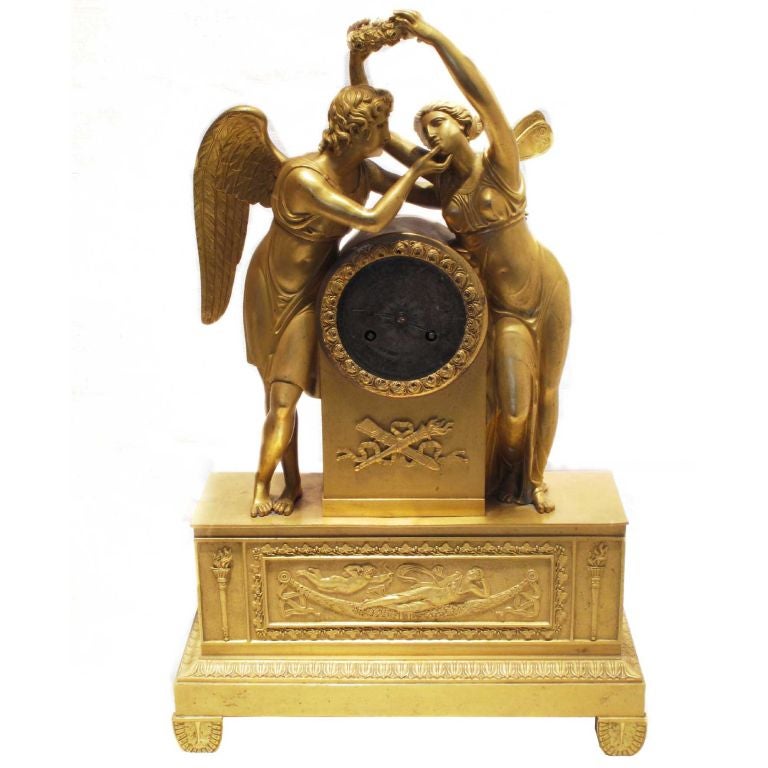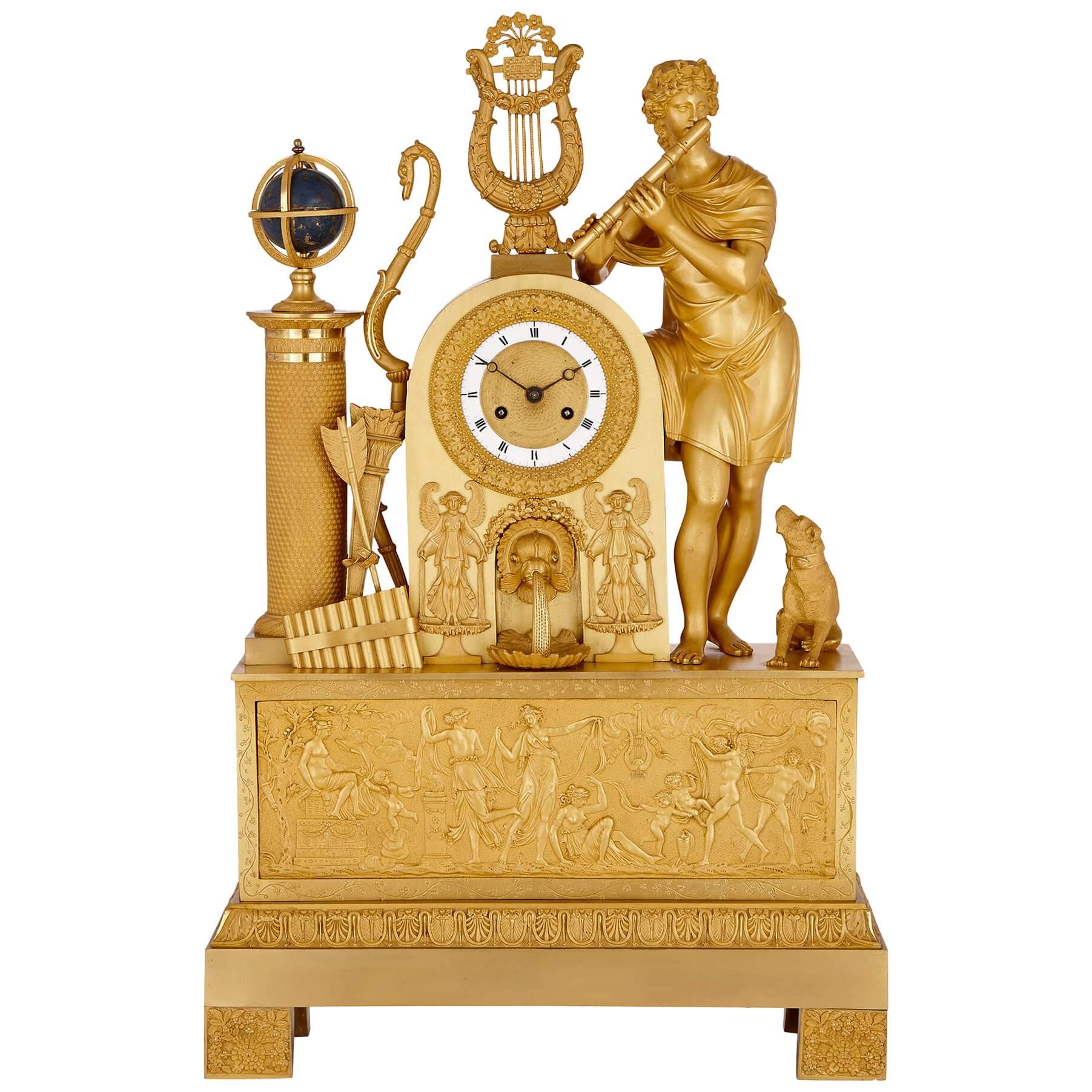Items Similar to Empire Gilt Bronze Clock of Standing Classical Lady Unveiling an Urn of Plenty
Video Loading
Want more images or videos?
Request additional images or videos from the seller
1 of 14
Empire Gilt Bronze Clock of Standing Classical Lady Unveiling an Urn of Plenty
About the Item
A late French Empire mantle clock in gilded bronze depicting a standing classical lady on the left side of the clock plinth with her left arm outstretched holding drapery concealing the contents of a gilded urn. The urn contains numerous items including flowers; at her feet is a small lidded jewellery chest. The base she stands on has a frieze across the entire front showing a/the girl kneeling at her 'mothers' feet asking for a blessing. The quality of the bronze chasing is excellent as is the gilding.
The dial is signed Rolland Dapere a Marseille, who was most likely the retailer. The original movement rings the hours and halfs on a bell.
- Similar to:A. Ravrio (Clockmaker)
- Dimensions:Height: 17 in (43.18 cm)Width: 11.5 in (29.21 cm)Depth: 4.5 in (11.43 cm)
- Style:Empire (Of the Period)
- Materials and Techniques:
- Place of Origin:
- Period:
- Date of Manufacture:1825
- Condition:Wear consistent with age and use. The gilding on the base is showing signs of rubbing and tarnishing, however, the gilding on the figure, urn, frieze is excellent.
- Seller Location:Vancouver, CA
- Reference Number:1stDibs: LU4631233318452
About the Seller
4.9
Vetted Seller
These experienced sellers undergo a comprehensive evaluation by our team of in-house experts.
Established in 1981
1stDibs seller since 2019
139 sales on 1stDibs
Typical response time: 3 hours
- ShippingRetrieving quote...Ships From: Vancouver, Canada
- Return PolicyThis item cannot be returned.
More From This SellerView All
- French Early 19th Century Empire Gilt Bronze Dragon Handled Urn ClockLocated in Vancouver, British ColumbiaAn rare model French Empire mantle clock featuring a classical urn with dragon handles. The clock is entirely of gilded bronze with original fire gilding. The urn-shaped case is surm...Category
Antique Early 19th Century French Empire Mantel Clocks
MaterialsBronze
- French Empire Gilt Bronze Allegorical Clock of the Astronomical SciencesLocated in Vancouver, British ColumbiaA fine example of a period French Empire mantle clock in finely chased and gilded bronze made in France in the first quarter of the 19thC. One of the Greek muses with a star atop h...Category
Antique Early 19th Century French Empire Mantel Clocks
MaterialsBronze
- French Empire Figurative Gilt Bronze Clock of a Roman Youth Holding a ScrollBy Rossel in RouenLocated in Vancouver, British ColumbiaA French Empire figurative clock of a Roman youth holding a scroll in gilded bronze showing a seated classically draped youth sitting atop the clock case holding a lyre in one hand a...Category
Antique Early 19th Century French Empire Mantel Clocks
MaterialsBronze
- Allegorical French Empire Gilt Bronze Clock Depicting Earth’s Source of WaterLocated in Vancouver, British ColumbiaA gilt bronze French Empire clock depicting an allegory to the earth’s water source. In this clock a classically draped nymph sits atop a rocky outcrop her right foot resting on the ...Category
Antique Early 19th Century French Empire Mantel Clocks
MaterialsBronze
- French Empire Gilt and Patinated Bronze Clock of a Seated Roman EmperorBy Claude GalleLocated in Vancouver, British ColumbiaA late French Empire period mantel (fireplace) clock showing a seated Roman emperor in finely chased patinated bronze holding a sword in one hand and a Roman banner in the other. He ...Category
Antique 1810s French Empire Mantel Clocks
MaterialsBronze
- French Empire Gilt Bronze and Marble Clock of Seated Cupid Holding a RoseBy Claude Hemon, Pierre-Victor LedureLocated in Vancouver, British ColumbiaFinest quality period French Empire clock depicting a seated winged cupid holding a rose; the case in gilt and patinated bronze. The clock show a gilt cupid sitting cross legged on t...Category
Antique Early 19th Century French Empire Mantel Clocks
MaterialsMarble, Bronze
You May Also Like
- French Empire Gilt Bronze ClockLocated in London, GBFrench Empire gilt bronze clock French, early 19th century Measures: Height 38cm, width 27cm, depth 10cm This fine gilt bronze man...Category
Antique Early 19th Century French Empire Mantel Clocks
MaterialsBronze, Ormolu
- Empire Period Gilt Bronze ClockLocated in Montreal, QCEmpire period gilt bronze figural clock representing Amour & Psyche.Category
Antique 19th Century French Empire Clocks
MaterialsBronze
- Clock in Gilt Bronze, Empire PeriodLocated in Saint-Ouen, FRClock in chiselled and gilt bronze composed by a rectangular base on which stand the dial-plate and a statuette of Bacchus. Round dial-plate with Roman numbers off-center on the righ...Category
Antique 19th Century European Empire Table Clocks and Desk Clocks
MaterialsBronze
- Empire Gilt and Patinated Bronze ClockLocated in Kittery Point, MEModelled as a potted flower, the pot decorated with gilt bronze classical figures. With an 18th century English movement.Category
Antique 19th Century Austrian Empire Clocks
MaterialsBronze
- Empire Period Gilt Bronze Mantel ClockLocated in London, GBThis truly stunning French mantel clock was crafted during the Empire period, and reflects the Neoclassical interests of the Emperor Napoleon I, whose influence over the decorative arts contributed toward a profound revival of beauties of the ancient empires. The mantel clock is crafted entirely in gilt bronze, and features a stepped base on four block feet. The base depicts a Classical relief panel to the front, showing female dancing figures and putti, as well as musical instruments. Surmounting the base is an arch featuring a central mask fountain and basin...Category
Antique Early 19th Century French Empire Mantel Clocks
MaterialsOrmolu, Bronze
- Empire Clock in the Form of a Classical Urn, by Maison Lepautre, circa 1825By Pierre-Basile LepauteLocated in Brighton, West SussexA gilt bronze Empire clock in the form of a classical urn, by Maison Lepautre. French, circa 1825. The dial signed 'Lepaute a Paris'. The clock has an ornate cast bezel with a 3-inch porcelain dial with Roman numerals and Breguet style hands. The twin train eight-day movement with outside count wheel striking on a bell and silk thread suspension. This elegant Empire style clock has a gilt bronze case in the form of a classical urn with swan neck handles and a winged cherub to the neck. The circular pedestal base is raised on a footed stepped square plinth. The Lepaute family were the premier French clockmakers of their day. Their significance lies in their contribution to the clock making industry which had hitherto come under the trade of locksmiths. The family held the brevet Horlogers du Roi. Jean-André Lepaute (1720–1789) arrived in Paris at an early age and in 1740 founded the family business. A skilled artist and mechanic, he quickly gained an excellent reputation. He was received as maître by the clockmakers guild in 1759, was granted royal lodgings from the king in The Luxembourg Palace, and was entrusted with the construction of the majority of the great public clocks of Paris. He executed, amongst others, those in The Luxembourg Palace, the Jardin des Plantes, the Château de Bellevue and the Château des Ternes. His clock at Paris’s École Militaire still works today. Three editions of his Traité d’Horlogerie were published in Paris in 1755, 1760 and 1767. A small volume, Description de Plusieurs Ouvrages d’Horlogerie appeared in 1764. Jean-André’s wife, Nicole-Reine Etable de la Brière (1723-1788), was a highly esteemed mathematician and astronomer. Her passion for science lent itself to Lepaute’s work and she played an active role in the scientific and mathematical aspects of the clock making. Jean-André’s younger brother Jean-Baptiste Lepaute (1727-1802) joined him in Paris in 1747 and immediately started working for the family business. He was received as maître in 1776 and was known for the clocks he constructed for the Paris Hôtel de Ville (1780), destroyed in a fire of 1871, and for the Hôtel des Invalides (1784). Jean-Baptiste took over the workshop when Jean-André retired in 1775. After Jean-Baptiste’s death in 1802, the firm was taken over by his nephew Pierre-Basil Lepaute (1750-1843) where he was duly joined by his own nephew Jean-Joseph (1768-1846) and son Pierre-Michel (1785-1849). By 1816, Pierre-Michel Lepaute was in charge of the business. His masterpieces include the astronomical clock in Paris’s Bureau...Category
Antique Early 19th Century French Empire Mantel Clocks
MaterialsBronze





